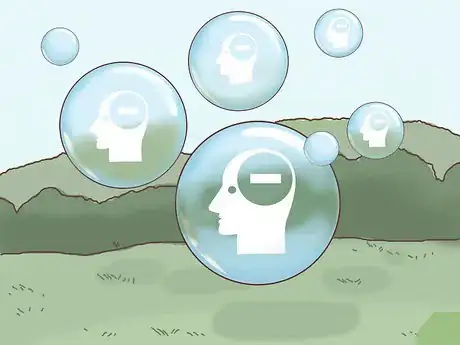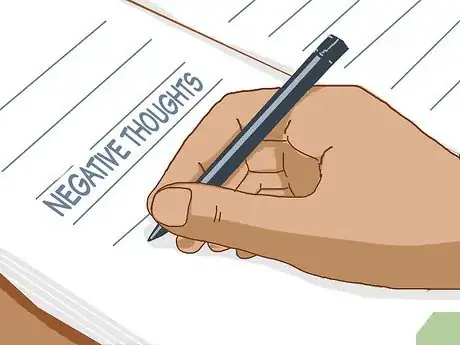This article was co-authored by Chad Herst, CPCC. Chad Herst is the Executive Coach at Herst Wellness, a San Francisco-based wellness center focused on Mind/Body Coaching. Chad is an accredited Co-Active Professional Coach (CPCC) and he has been working in the wellness space for over 19 years, with experience as a yoga teacher, acupuncturist, and herbalist. He received his BA from Columbia University and his MS in Traditional Chinese Medicine from the Pacific College of Oriental Medicine.
There are 8 references cited in this article, which can be found at the bottom of the page.
This article has been viewed 20,235 times.
Everyone experiences negative thoughts occasionally. While these sometimes help you avoid dangerous situations, they can also depress you and take a toll on your mental health. If you struggle with negative thinking, a short-term coping strategy is ignoring the thoughts when they enter your mind. Stop and breathe when you experience a negative thought. Distract your mind with a different, positive thought and other activities. Surround yourself with more positive people and media to reduce your negative thinking. For a more long-term strategy, keep a thought journal to assess your thoughts and develop coping strategies when you’re feeling negative.
Steps
Getting Rid of Negative Thoughts
-
1Stop and breathe when negative thoughts enter your head. Eliminating negative thoughts requires some mindfulness and relaxation. When the thought enters your head, recognize it and stop to assess it. Purposely stop, take a breath, and clear your head to isolate the thought.[1]
- Always take some time to pause because your mind doesn’t think straight when you’re flustered. Suppressing the thought is much easier when you’re relaxed.
-
2Ask yourself if the thought is helpful. Not all negative thoughts are bad. Some negative thoughts help you avoid danger, and are a necessary part of survival. After you’ve slowed down and identified the negative thought, assess it. Is this thought helping you, or is it just causing you anxiety? Proceed based on the answer.[2]
- An unhelpful negative thought is usually about something you can’t control. If you’re on a cruise and keep getting worried that the boat will sink, this is unhelpful because there is nothing you can do about it in the moment. This thought only causes you anxiety.
Advertisement -
3Listen to helpful negative thoughts to avoid danger. Negative thoughts aren't all bad. Sometimes, they represent something that will actually happen, and you need to respond to those thoughts. Think about if this thought represents a real threat and is something that you can control. If so, then listen to the thought and take appropriate action to protect yourself.[3]
- If you’ve had a bad fever for a week, for example, you’d be right to think that something is wrong and should see a doctor. This is a helpful negative thought and you should listen to it instead of ignoring it.
- Use negative thoughts to plan for the future as well. If you spend a lot of money on frivolous things and don't have savings put away, you'd be right to worry about what would happen if you had an emergency expense. Respond by reducing your spending and saving more money.
-
4Visualize unhelpful negative thoughts floating away. This may sound silly, but it’s a powerful visualization tool. When you identify a negative thought as unhelpful, then imagine it inside a bubble floating away from you. This figuratively removes the thought from your mind.[4]
- A similar visualization tool is imagining the thought on a leaf that blows away in the wind. Any visualization will work.
-
5Displace negative thoughts with something positive if it doesn't go away. Your mind has trouble focusing on 2 thoughts at the same time, so replacing a negative thought with a positive one can force it right out of your head. Pick a good memory or thought and force yourself to think about that instead of the negativity.[5]
- One helpful technique is reversing the negative thought you had. If the thought was telling you that you’d strikeout in your next at-bat, imagine hitting a home run instead.
- If your negative thoughts always focus on the same thing, then have a stock positive thought that you always use to replace it with. You might always worry that your business will fail. Replace that thought by imagining yourself being interviewed by Forbes as a successful entrepreneur every time it enters your mind.
-
6Distract yourself with different activities if you can't focus your mind. If you’re having trouble displacing the negative thoughts with mental efforts, then try some activities to distract yourself. Ideally, do something you enjoy to raise your mood. Most activities, however, can refocus your mind and push out the negative thoughts.[6]
- Physical activity is a good way to distract your mind. Exercise releases endorphins and improves your mood. Try some light exercise or walking to distract your mind.
- If you’re at work or school, it might be harder to do some activities. Try switching to a new task for a little while, or getting up to get a cup of coffee to take a quick break.
- Don’t use destructive behaviors like drinking or using drugs to get rid of negative thoughts. These have long-term health consequences and aren’t a productive way to solve problems.
Developing a More Positive Mindset
-
1Speak to yourself the way you’d speak to other people. Remember that your inner thoughts represent the way you talk to yourself. Consistent negative thoughts mean that you’re telling yourself to be negative. Consider if you’d ever speak to another person that way. In most cases, you wouldn’t, because that’s rude and unfriendly. Adjust your inner thoughts and speak to yourself in a way that you’d speak to other people.[7]
- Think of this as being a friend to yourself. You wouldn’t want to bring your other friends down, so why would you bring yourself down?
- Talking to yourself kindly takes practice. Just like how lifting weights at the gym will help you develop muscles, practicing talking to yourself kindly will help you develop a more positive sense of self.[8]
-
2Surround yourself with other positive people to brighten your mood. The people you spend time with have a big impact on the way you think. If you’re always around negativity, then it’s much harder to eliminate negative thinking. Instead, seek out people who are positive, outgoing, and productive. Spending more time with them will raise your own mood and make it much easier to think positive thoughts.[9]
- If you already have positive friends in your group, try to spend more time with them. If you don’t have many positive friends, then branch out and meet new people.
- You don’t necessarily have to eliminate negative people entirely, especially if they’re friends. But develop boundaries with them. See them less often so you’re less surrounded by negative thoughts.
-
3Read and watch more positive media. Constantly consuming negative news can depress your mood significantly. Sometimes taking a step back and ignoring the world a bit is good for your mental health. Unplug from the news a bit and consume some more positive media. Whether it’s watching a movie, reading success stories, or looking at cat videos, give yourself some time to be happy and away from negativity.[10]
- Having a positive morning routine is a great way to set yourself up for success. Instead of watching the news over breakfast, read feel-good success stories. This puts you in a positive mindset right from the start of the day.
- Remember that this doesn’t mean you have to tune out the world or be uninformed. It just means you’re taking a break from bad news for your own mental health.
-
4Avoid comparing yourself to others. Comparing yourself to others, especially those more successful than you, is a major cause of anxiety and depression. Focus on yourself and your own goals and accomplishments. Don't get distracted by focusing on what others have. What other people have doesn't reflect on your own accomplishments.[11]
- Social media is a major reason for these comparisons. If you have to, stop following or block people who make you jealous or feel negative.
- Remember that many forms of media, including social media, show ideal images rather than reality. If you have to, cut these forms of media out altogether.
- If you're feeling jealous of friends or family, do your best to be happy for them. Remember that their successes don't invalidate your own life.
Learning How to Assess Your Thoughts
-
1Learn the main types of negative thinking. You can assess your thoughts much more effectively if you can break them down in a clinical way. Psychologists use 5 main categories to describe negative thoughts. Learn each one so you can identify what kind of thought you’re having.[12]
- “Focusing on the bad” means that you’re ignoring all positive outcomes and only thinking about the negative ones.
- “Should” thinking means that you’re putting too much stress on yourself and thinking about what the outcome should be, rather than thinking about constructive steps to reach your goals.
- “Overgeneralizing” means that you’re using broad statements like “I never feel happy” or “I’ll never be okay.” These are exaggerations and make you feel worse.
- “All-or-nothing” thinking means that you only see black or white outcomes. For example, “If my work isn’t perfect on this assignment, I’ll lose my job and become homeless.” In reality, the world is much more nuanced than this, and outcomes aren’t so clear-cut.
- “Catastrophic” thinking is when you focus on the worst possible outcome of a situation. If you have a headache and automatically assume you have a brain tumor, then you’re being catastrophic.
-
2Keep a thought journal and write down your negative thoughts. If you’re consistently overcome with negative thoughts, keep track of them. Write down what the thought was, when you felt that thought, and what type of negative thought it was. Look for a pattern in these thoughts. Perhaps a certain situation always makes you feel anxious, or maybe you’re a habitually catastrophic thinker. Once you analyze your thought patterns, you can develop constructive responses to negative thoughts that directly counter what you're feeling.[13]
- Hold on to this journal and bring it with you if you ever talk to a therapist. They will want to see your thought patterns, and will probably suggest you keep a journal anyway if you haven’t made one yet.
-
3Write down a stock response to negative thoughts. After you’ve assessed your thoughts, plan out how you’ll respond when they enter your head. Pick a thought, memory, or counter-argument you’ll use to eliminate that thought. Study your journal so you remember your responses.[14]
- Your responses depend on what type of thoughts you have. If you’re a catastrophic thinker, then remind yourself that the worst possible scenario rarely happens and you’re only causing yourself anxiety by focusing on it.
- If a response isn’t working for you, then go back and analyze your thoughts again. Develop a new response and see if that works better.
Expert Q&A
Did you know you can get expert answers for this article?
Unlock expert answers by supporting wikiHow
-
QuestionDo I have to ignore my negative thoughts?
 Chad Herst, CPCCChad Herst is the Executive Coach at Herst Wellness, a San Francisco-based wellness center focused on Mind/Body Coaching. Chad is an accredited Co-Active Professional Coach (CPCC) and he has been working in the wellness space for over 19 years, with experience as a yoga teacher, acupuncturist, and herbalist. He received his BA from Columbia University and his MS in Traditional Chinese Medicine from the Pacific College of Oriental Medicine.
Chad Herst, CPCCChad Herst is the Executive Coach at Herst Wellness, a San Francisco-based wellness center focused on Mind/Body Coaching. Chad is an accredited Co-Active Professional Coach (CPCC) and he has been working in the wellness space for over 19 years, with experience as a yoga teacher, acupuncturist, and herbalist. He received his BA from Columbia University and his MS in Traditional Chinese Medicine from the Pacific College of Oriental Medicine.
Mindfulness Coach
-
QuestionHow do you stop reacting to bad thoughts in your head?
 Chad Herst, CPCCChad Herst is the Executive Coach at Herst Wellness, a San Francisco-based wellness center focused on Mind/Body Coaching. Chad is an accredited Co-Active Professional Coach (CPCC) and he has been working in the wellness space for over 19 years, with experience as a yoga teacher, acupuncturist, and herbalist. He received his BA from Columbia University and his MS in Traditional Chinese Medicine from the Pacific College of Oriental Medicine.
Chad Herst, CPCCChad Herst is the Executive Coach at Herst Wellness, a San Francisco-based wellness center focused on Mind/Body Coaching. Chad is an accredited Co-Active Professional Coach (CPCC) and he has been working in the wellness space for over 19 years, with experience as a yoga teacher, acupuncturist, and herbalist. He received his BA from Columbia University and his MS in Traditional Chinese Medicine from the Pacific College of Oriental Medicine.
Mindfulness Coach
-
QuestionHow can I reframe negative self-talk?
 Chad Herst, CPCCChad Herst is the Executive Coach at Herst Wellness, a San Francisco-based wellness center focused on Mind/Body Coaching. Chad is an accredited Co-Active Professional Coach (CPCC) and he has been working in the wellness space for over 19 years, with experience as a yoga teacher, acupuncturist, and herbalist. He received his BA from Columbia University and his MS in Traditional Chinese Medicine from the Pacific College of Oriental Medicine.
Chad Herst, CPCCChad Herst is the Executive Coach at Herst Wellness, a San Francisco-based wellness center focused on Mind/Body Coaching. Chad is an accredited Co-Active Professional Coach (CPCC) and he has been working in the wellness space for over 19 years, with experience as a yoga teacher, acupuncturist, and herbalist. He received his BA from Columbia University and his MS in Traditional Chinese Medicine from the Pacific College of Oriental Medicine.
Mindfulness Coach
References
- ↑ https://www.forbes.com/sites/forbescoachescouncil/2018/04/25/11-ways-to-stop-negative-thought-patterns-and-move-forward/#7802b0bc19ff
- ↑ https://www.psychologytoday.com/us/blog/shyness-is-nice/201305/stop-fighting-your-negative-thoughts
- ↑ https://www.psychologytoday.com/us/blog/long-fuse-big-bang/201007/why-negative-thinking-is-good-you
- ↑ https://www.psychologytoday.com/us/blog/shyness-is-nice/201305/stop-fighting-your-negative-thoughts
- ↑ https://www.forbes.com/sites/forbescoachescouncil/2018/04/25/11-ways-to-stop-negative-thought-patterns-and-move-forward/#7802b0bc19ff
- ↑ https://www.inc.com/lolly-daskal/how-to-tame-your-negative-talk-in-your-mind.html
- ↑ https://www.inc.com/lolly-daskal/how-to-tame-your-negative-talk-in-your-mind.html
- ↑ Chad Herst, CPCC. Mindfulness Coach. Expert Interview. 22 March 2019.
- ↑ https://www.forbes.com/sites/forbescoachescouncil/2018/04/25/11-ways-to-stop-negative-thought-patterns-and-move-forward/#7802b0bc19ff
- ↑ https://www.forbes.com/sites/forbescoachescouncil/2018/04/25/11-ways-to-stop-negative-thought-patterns-and-move-forward/#7802b0bc19ff
- ↑ https://www.psychologytoday.com/us/blog/prescriptions-life/201803/how-stop-comparing-yourself-others
- ↑ https://www.uofmhealth.org/health-library/uf9897
- ↑ https://www.uofmhealth.org/health-library/uf9897
- ↑ https://www.uofmhealth.org/health-library/uf9897








































































